

The Manufacturers of Automated Instruments from Leipzig - Products and Patents between 1876 and 1930
Catalogue by Birgit Heise
Translation: Maria Heyne
This database contains approximately 600 pages of text and provides complete listings and descriptions of the manufacturers of automated instruments from Leipzig in the German language.
Organized by makers, the following information is presented:
The reader has the option of searching by entering either the name of the manufacturer or the name of a specific person. Results will include all data and facts (see company name index). A search by product is possible as well (product index), if, for example, the maker of the instrument is unknown.
We appreciate any further information regarding the companies and products and kindly ask you to use the "contact" link.
Sources
In addition to company-specific publications including numerous sales catalogues (i.e. catalogues of Ernst Holzweißig succ.), the following materials have been used to build the database:
Address books of the city of Leipzig between 1876 and 1930 (LAB)
Public records in the city archives
Company Assets in the Sächsischen Staatsarchiv (Saxony State Archives)
Chamber of commerce reports
World address books of the musical instrument industry by Paul de Wit 1890-1926
Journal of instrument making (Paul de Wit, Leipzig, since 1880)
Leipzig as a production center for automated instruments
Between 1880 and 1930, Leipzig experienced a period of growth that was exceptional for the central European area. The city, which has a long-standing tradition of making keyboard and wind instruments, became a world-renown production center of automated instruments. This development brought about economical as well as cultural advantages and took place in two steps. Between 1880 and 1900, numerous kinds of perforated disc players dominated the market. Between 1900 and 1920, thousands of pneumatic pianos and piano orchestrions were distributed from Leipzig. Automated instruments from Leipzig were considered a worthy acquisition for half a century, as can be seen from these figures:
Which types of musical instruments came from Leipzig?
1. Organetten
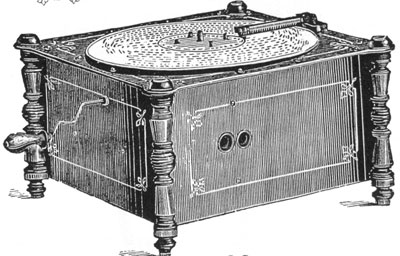
Organettes with perforated discs were developed in 1882 by Paul Ehrlich in Leipzig, the main production location. The automated free reed aerophone instruments contained wind channels and bellows. A crank operated both the bellows and the part of the instrument containing musical information (disc, perforated band, cylinder, and others). The opening and closing of the valves for tone production was automated with the help of a lever mechanism, which was set in motion whenever the disc (or cloth) moving above it contained a hole corresponding to the respective tone. Most models were equipped with a range between 16 and 26 pitches and operated with the use of air suction.
Especially the organettes of PAUL EHRLICH, but also those of PHÖNIX and EUPHONIKA, were distributed worldwide. Most models of these makers were sold as table (jewel case) instruments. The cases of the instruments of all three makers had similar characteristics. The range of the PAUL EHRLICH 16 (Helikon) included up to 36 pitches (Salon-Ariston), the PHÖNIX 14 (all children’s instruments) could produce up to 42 tones, and the EUPHONIKA ranged between 16 and 36 pitches. The reeds were made from brass or steel; better models were equipped with high-quality free reeds imported from the USA. Experts, however, were able to distinguish the instruments of the different makers. PHÖNIX instruments were said to have the most pleasant timbre, the Aristons made by PAUL EHRLICH were best known due their huge disc repertoire, and EUPHONIKA distinguished themselves by means of volume and effects, such as dancing figurines.
Organette models produced in Leipzig including production start and manufacturers:
| 1876 | Fabrik Leipziger Musikwerke vormals PAUL EHRLICH | Orchestrionette |
| 1881 | Fabrik Leipziger Musikwerke vormals PAUL EHRLICH | Non plus ultra |
| 1882 | Fabrik Leipziger Musikwerke vormals PAUL EHRLICH | Ariston |
| 1886 | Leipziger Musikwerke PHÖNIX | Phönix |
| 1891 | Leipziger Musikwerke PHÖNIX | Laetitia, Ariosa |
| 1896 | Leipziger Musikwerke EUPHONIKA | Amorette |
| 1897 | Leipziger Musikwerke PHÖNIX | Intona |
| 1901 | Zimmermann, Julius Heinrich | Orgophon |
| 1904 | Ehrlichs Musikwerke Emil Ehrlich | Ehrlichs Instrument Nr.7 |
| 1905 | Leipziger Musikwerke PHÖNIX | Diana |
| 1905 | Neue Leipziger Musikwerke Adolf BUFF-HEDINGER | Empire |
| 1906 | Neue Leipziger Musikwerke Adolf BUFF-HEDINGER | Ariston, Helikon Z, Monopol |
| 1909 | Leipziger Musikwerke PHÖNIX | Lucia |
| 1912 | Holzweissig, Ernst | Amorette |
| 1913 | Leipziger Musikwerke PHÖNIX | Otero |
| 1920 | Holzweissig, Ernst | Diana, Intona, Phönix, Ariosa |
2. Automated Harmonicas
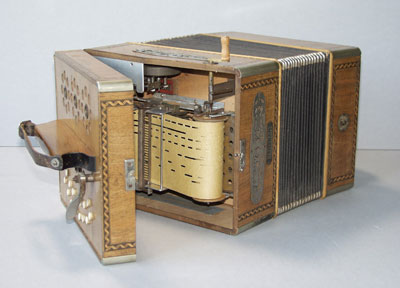
An accordion (bandoneón or concertina) was used to create sounds. The discs and cylinders were set in motion by clockworks or a mechanism coupled with the bellow movement (“Nuremberg scissors”). Similar to the organettes, the opening and closing of the air channels was automated through the use of stechers and claves.
The accordion bellows allowed the player to regulate the volume by adjusting the strength of the push and pull. The otherwise pre-set music could thus be interpreted somewhat individually, which proved to be an advantage to other automated instruments such as the organette.
Older models of the brands Sonatina and Euphonika were operated with round perforated discs. However, as with other perforated disc players, the piece of music only lasted one full rotation of the disc and would then start from the beginning. It is thus not surprising that continuously successful sales were not achieved until the introduction of the Tanzbär (“Dancing Bear”). The paper music rolls allowed for a much longer playing time. Another advantage was the innovative operation: the usage of an additional crank (Ratschenhebel) allowed for the perforated strips to unroll independently from the bellow motion, which in turn made it possible for the player to regulate tempo in addition to volume.
Leipzig manufacturers, product names, and date of production start:
1895
Leipziger Musikwerke SONATINA
Sonatina
1896
Leipziger Musikwerke EUPHONIKA
Euphonika
1905 (ca.)
Zuleger, A
Tanzbär
3. Automated Harmoniums
.jpg)
A conventional harmonium, often using suction airflow, served as the resonator. Similar to automated pianos, perforated discs or music rolls were used in Leipzig during the 1890s; after 1900, only harmoniums using music rolls were produced. The transition from the music roll to the valve was done mechanically in earlier models and pneumatically after 1900 with the use of a perforated music roll.
Mechanically operated Harmoniums
Leipzig manufacturers, product names (when available), and date of production start:
1887
Grob, J.M.
(Klavier- und Harmonium-Vorsetzer)
1888
Fabrik Leipziger Musikwerke vormals PAUL EHRLICH
Daimonion (Klavier-Harmonium)
1892
Hupfeld, Ludwig
Pneumatically operated Harmoniums
Leipzig manufacturers, product names (when available), and date of production start:
1908(ca.)
Hörügel, M.
1908
Popper, Polyphon
Mystikon, Klavier-Harmonium
1910
Mannborg
1910
Neue Leipziger Musikwerke Adolf BUFF-HEDINGER
Premier
1910
Hofberg, Magnus
Hofbergs Auto-Harmonium
1913(ca.)
Hupfeld, Ludwig
Clavimonium (Klavier-Harmonium)
1914(ca.)
Popper
Estrella
1914
Hofberg, Magnus
Combinations-Auto-Harmonium
1920(ca.)
Zuleger, A.
Harmonola
1926(ca.)
Hörügel, M.
Hera
4. Musical Combs
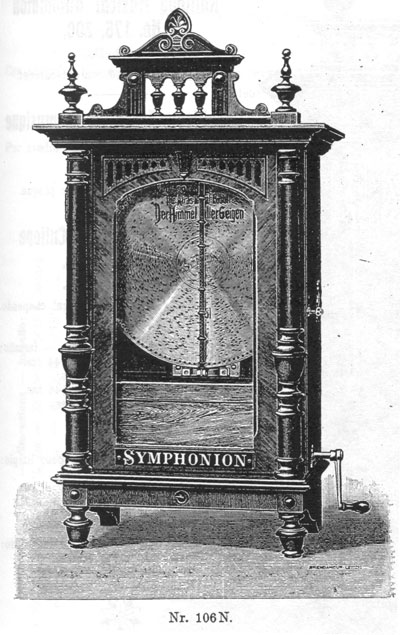
The musical comb (tone comb, comb reeds) is the only resonator constructed exclusively for automated instruments. Vibrating reeds of different length and weight are cut out of a steel plate and sound when struck. While this comb had already been used in Swiss music boxes since 1820, it was first combined with round perforated discs in Leipzig. Rotating cogwheels (Sternenrädchen) were thus set into motion, and in turn struck the comb reeds to produce sounds. The discs, which were between 11 and 85 cm in diameter, were mostly made from steel.
Thiese types of mechanic disc players were invented by Paul Lochmann (→SYMPHONION) in Leipzig, the main center of production. With the invention of the Sternenrädchen cogwheels (patent in Great Britain only, patent no. 11261 of September 22, 1885), the expedient connection between perforated disc and musical comb could be accomplished. From small jewelry boxes to crank-operated cupboards with clockworks: These types of disc players sold successfully all over the world. Lochmann thus created an entire branch of industry with several thousand workers.
Additionally, musical comb disc players with collapsible boxes featuring a much longer playing time were produced in Leipzig.
Leipzig manufacturers of perforated disc players with product names and start of production:
1886
Symphonion
Symphonion
1890
Brachhausen & Rießner
Polyphon
1890
Fabrik Leipziger Musikwerke vormals PAUL EHRLICH
Elly
1891
Orphenion-Musikwerke
Lyraphon
1892
Orphenion-Musikwerke
Orphenion
1893
Fabrik Leipziger Musikwerke vormals PAUL EHRLICH
Monopol
1894
Komet Musikwerke
Komet
1894
Neumann, A.
Enterpephon
1895
Kalliope Musikwerke
Kalliope
1895
Polyphon
Polyphon
1896
Adler
Adler
1896
Sirion
Sirion
1896
Weigel, C.H.
1897
Musikwerke Orpheus
Orpheus
1897
Fabrik mechanischer Musikwerke Troubadour
Troubadour
1898
Musikwerke Tannhäuser
Tannhäuser
1898
Troubadour Musikwerke
Troubadour
1899
Original Musikwerke Paul Lochmann
Original
1900
Adler
Fortuna
1900
Zimmermann, J.H.
Fortuna
1901
Phänomenal-Musikwerke
Phänomenal
| 1891 | Fabrik Müllerscher Musikwerke | Hymnophon |
| 1891 | Plagwitzer Musikwerke ARIOPHON | Ariophon |
| 1891 | Leipziger Musikwerke LIBELLION | Libellion |
|
1896 |
Roepke |
5. Mechanically operated Zithers
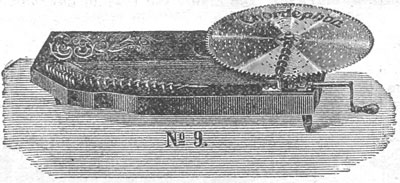
This mechanically operated instrument is based on a zither without fingerboard. Controlled by perforated discs or music rolls, the strings of the instrument were caused to vibrate to an extend that allowed for the production of sounds similar to those of the concert zither. The Chordephon zither, made by a company with the same name, enjoyed long-lasting success. The crank-operated instrument, which used perforated discs as well as clockworks, was available with 30, 44, or 60 strings.
Leipzig manufacturers and their products with start of production:
| 1892 | Hupfeld, Ludwig | Cymbalpianette |
| 1895 | Hupfeld, Ludwig | Arpanetta |
| 1895 | Fabrik mechanischer Zithern Chordephon | Chordephon |
| 1922 | Popper | Triola |
6. Mechanically operated Percussion Instruments
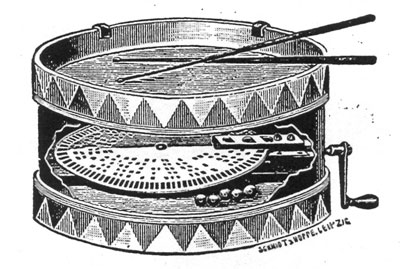
Automated percussion instruments manufactured in Leipzig mainly consisted of children’s toys. Boys’ and children’s ensembles mainly used mechanically operated bell lyres (portable glockenspiels) and small, crank operated drums in order to produce automated march rhythms and drum rolls. These bell lyres and automated drums completed small marching bands and could be operated by any child regardless of their skills in drumming and music reading.
Leipzig manufacturers of glockenspiels and their product names with start of production:
| 1896 | Uhlig, Schwerin & co | Kaleidophon |
| 1906 | Leipziger Musikwerke EUPHONIKA | Glockenspiel |
Leipzig manufacturers of mechanically operated drums with start of production:
| 1903 | Meinel, Ottomar | |
| 1904 | Apollo Musikwerke | |
| 1905 | Herkules-Musikwerke |
7. Automated String Instruments
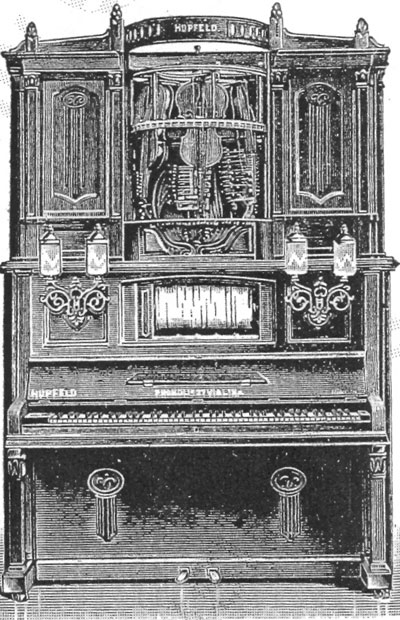
Between 1884 and 1930, Leipzig produced 28 patents and 38 registered patterns for mechanically operated string instruments. However, few of these ideas were realized. The Pentaphon bowed zither (POLYPHON) was popular for some time, but the automated violins by DIENST and POPPER hardly sold. One exception was the Violina made by HUPFELD; genuine violins with revolving horsehair bows (circular bows) were a highlight in the production of automated instruments and hence remained in demand until about 1930.
Instruments made in Leipzig with start of production and manufacturers:
| 1900 |
Polyphon |
Pentaphon, Polyphon-Streichmusikwerk |
| 1907 | Popper | Animochord |
| 1908 | Hupfeld, Ludwig | Violina |
| 1911 |
Dienst, E. |
Dienst’s selbstspielende Geige |
| 1930 | Popper | Violinovo |
8. Mechanically operated Pianos, Player Pianos and Vorsetzer
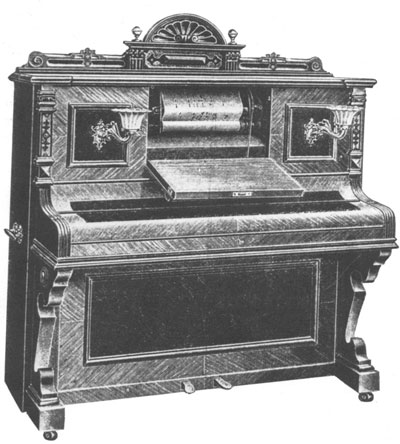
8.1. Mechanically operated Pianos and Piano Players (Vorsetzer)
Starting in 1887, automated pianos operated by perforated discs were produced in Leipzig. Earlier models featured a box (Vorsetzer), which would be placed in front of the piano. The automated player piano contained between 24 and 36 playing levers, which functioned as pianist fingers. The disc could be set into motion with the rotation of a crank. The playing levers would jump into the stamped out holes and thus strike the keys lying underneath forcefully. Playing forte and piano was somewhat limited.
Starting in 1892, Leipzig factories produced automated pianos with integrated mechanics inside the instruments. Instead of discs, perforated strips made from paper and cardboard were used.
Leipzig manufacturers and their models with start of production:
Vorsetzer
| 1887 | Grob, J.M | Clavierspieler |
| 1887 | Fabrik Leipziger Musikwerke vormals Paul Ehrlich | Clavier-Automat |
| 1892 | Hupfeld, Ludwig | Klavierspieler |
Selbstspielende Klaviere
| 1888 | Fabrik Leipziger Musikwerke vormals Paul Ehrlich | Daimonion (mit Harmonium) |
| 1892 | Fabrik Leipziger Musikwerke vormals Paul Ehrlich | Drehpiano |
| 1892 | Hupfeld, Ludwig | Mechanisches Klavier |
| 1907 (ca.) | Hupfeld, Ludwig | Elektrisches Klavier |
| 1912 | Original Musikwerke Paul Lochmann | Original-Orchester-Klavier Nr. 50 |
8.2. Pneumatic Vorsetzer and Player Pianos
Due to their monotonous timbre, mechanically operated pianos were not suited for the interpretation of challenging masterpieces. Nuanced, individual key pressure was made possible with the use of pneumatic mechanics using air suction and perforated paper rolls.
The bellows were operated by either two foot pedals (similar to the harmonium), or via a motor. While the American-made Pianola became increasingly popular toward the end of the 19th century, similar instruments had been manufactured in Leipzig since 1900.
Certain player pianos, such as the Phonola by HUPFELD, required a certain amount of artistic skill. The playing of the music roll could be influenced with the use of the pedals and various levers controlling volume and tempo (“artistic playing”).
“Reproductive playing”, however, required no further operation in addition to listening. With the introduction of the DEA System in 1907, HUPFELD created a reproductive piano of the highest standards. Some later models, including, for example, the 1920 Triphonola by HUPFELD, allowed for both artistic and reproductive playing.
Leipzig manufacturers and models with start of production:
Vorsetzer
| 1901 | Frömsdorf, R. & co. | Pianetta |
| 1901 | Hupfeld, Ludwig | Phonola |
| 1903 | Apollo Musikwerke | |
| 1904 | Ehrlichs Musikwerke Emil Ehrlich | Phonabella |
| 1904 | Stichel, F. | Claviola |
| 1905 | Neue Leipziger Musikwerke Adolf Buff-Hedinger | Premier |
| 1906 | Neue Leipziger Musikwerke Adolf Buff-Hedinger | Playola |
| 1906 | Ehrlichs Musikwerke Emil Ehrlich | Orphobella |
| 1906 | Pianotist | Pianotist |
Klaviere
| 1899 | Paul Ehrlich | |
| 1899 | Frömsdorf | Helios |
| 1904 | Hupfeld | Phonoliszt, Universal |
| 1905 | Hupfeld | Phonoliszta, Clavitist |
| 1906 | Neue Leipziger Musikwerke Adolf Buff-Hedinger | Playotist |
| 1907 | Neue Leipziger Musikwerke Adolf Buff-Hedinger | Premier |
| 1907 | Stichel | Claviola |
| 1907 | Hupfeld | Phonola-Piano, DEA |
| 1908 | Neue Leipziger Musikwerke Adolf Buff-Hedinger | Marcando-Premier, Primavolta |
| 1908 | Popper | Stella |
| 1908 | Symphonion | Symphoniola |
| 1909 | Popper | Regent |
| 1909 | Symphonion | Nuancierungsklavier |
| 1909 | Leipziger Orchestrionwerke Paul Lösche | Kunstspiel-Piano |
| 1910 | Neue Leipziger Musikwerke Adolf Buff-Hedinger | Melodant-Premier |
| 1910 | Popper | Welt-Piano „X“ Nr. 4 |
| 1911 | Neue Leipziger Musikwerke Adolf Buff-Hedinger | Elektra |
| 1911 | Popper | Estrella |
| 1912 | Polyphon | Polyphona |
| 1912 | Förster, H. & co | |
| 1913 | Popper | Superba |
| 1919 | Riedel, W. | |
| 1919 | Döhnert, Otto | |
| 1920 | Wöhle & co | |
| 1920 | Bachmann | |
| 1920 | Kästner | |
| 1920 | Hupfeld, Ludwig | Triphonola |
| 1923 | Birnbaum & co. | |
| 1926 | Popper | Electro-Flügel |
| 1926 | Leipziger Orchestrionwerke Paul Lösche | Selecta |
| 1926 | Kästner Autopiano | Nola de luxe |
| 1927 | Leipziger Orchestrionwerke Paul Lösche | Artista, Astra, Jazzband-Pianos |
| 1927 | Riedel, W. | Jazzband-Piano Preziosa |
| 1927 | Pyrophon | Pyrophon |
| 1927 | Kästner Autopiano | Triplex |
| 1928 | Döhnert, Otto | Symphona |
| 1928 | Kästner Autopiano | Reproduktions-Kästner-Autopiano |
| 1929 | Döhnert, Otto | Symphona Jazz-Piano |
| 1929 | Kästner Autopiano | Kästners Macar |
Einbau-Apparate
| 1908 | Neue Leipziger Musikwerke Adolf Buff-Hedinger | |
| 1909 | Symphonion | Symphoniola |
| 1920 | Wöhle & co | Pianobella, Elektrobella |
| 1923 | Schrickel, A. | |
| 1923 | Birnbaum & co | |
| 1925 | Zimmermann, Gebr. | |
| 1926 | Richter, C. | Riconola |
| 1926 | Kästner Autopiano | |
| 1926 | Riedel, W. | |
| 1927 | Katz, Conrad | |
| 1928 | Döhnert, Otto |
9. Piano Orchestrions
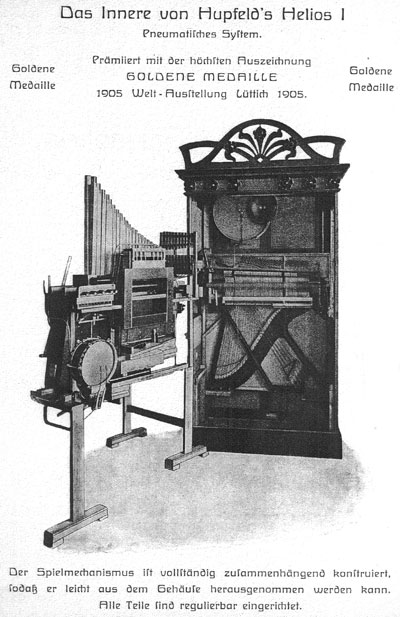
Orchestrions were meant to replace small or medium-sized instrumental ensembles. This explains the use of the name orchestrion (also: orchestra player), as well as numerous remarks in advertisements and sales catalogues (including, for example: “replaced approximately 5 musicians”, “replaces a military band” and “recreates a complete jazz band”.
Shortly after 1900, Leipzig became an important center for the production of piano orchestrions. The instruments were based on automated pianos. Additionally, they featured integrated percussion instruments such as large and small drums, timpani, triangles, glockenspiels and xylophones. Wind and string instruments were reproduced with organ pipes. Additional timbres, such as mandolin, zither, banjo and harp effects were produced at the piano strings with the use of specific mutes, modified hammer strokes (“vibrating hammers”), or, for example, with vibrating and clinking metal plates.
The greatest musical achievements were pneumatic orchestrions with perforated paper rolls, which were introduced after 1900. They were relatively expensive and required complex maintenance. Mechanically operated orchestrions were cheaper and more robust, however, they did not compare in terms of musical expression. They were largely popular in remote areas without electricity and maintenance personnel, such as village dance halls.
Mechanically operated orchestrions with cylinders, perforated discs and paper rolls were manufactured in Leipzig.
Leipzig manufacturers of mechanically operated cylinder orchestrions and their models with start of production:
| 1893 | Zimmermann, Gebr. | Piano-Orchestrion (auch Dreh-Piano) |
| 1901(ca.) | Hupfeld, Ludwig | Atlantic |
| 1901 | Dienst, E. | Dienst’s Piano-Orchestrion, Ideal, International, Geisha |
| 1903 | Dienst, E. | Konzert-Orchestrion Nr.1 |
| 1904 (ca.) | Popper | Adria, Carmen, Triumph, Titania, Austria, Roland |
| 1905 (ca.) | Popper | Liliput |
| 1906 (ca.) | Popper | Humor, Aida, Bravo |
| 1906 | Dienst, E. | Traviata |
| 1907 | Original Musikwerke Paul Lochmann | Original-Walzen-Orchestrion Nr. 1 |
| 1908 (ca.) | Popper | Italia |
| 1909 | Pyrophon | Walzenorchestrion Nr. 1 und 2 |
| 1913 | Original Musikwerke Paul Lochmann | Romania, Hansa |
Leipzig manufacturers of mechanically operated perforated disc orchestrions and their models with start of production:
| 1901 | Hupfeld, Ludwig | Orchestrophon |
| 1901 | Polyphon | Polyphon-Concerto |
| 1903 | Symphonion | Symphonion-Duplex-Orchester No 98 |
| 1903 | Original Musikwerke Paul Lochmann | Original-Konzert-Piano Nr. 350 |
| 1904 | Symphonion | Mandolinen-Orchester Nr. 70 |
| 1905 | Original Musikwerke Paul Lochmann | Original-Konzert-Pianos Nr. 200 und 250 |
| 1906 | Original Musikwerke Paul Lochmann | Original-Orchester-Pianos Nr. 400, 450, 500 |
| 1907 | Symphonion | Symphonion-Saitenorchester Nr. 76 |
| 1907 | Original Musikwerke Paul Lochmann | Original-Tanz-Automat Nr. 100 |
Leipzig manufacturers of mechanically operated music roll orchestrions and their models with start of production:
| 1900 | Ruhl, Oscar | Orchesterpiano |
| 1904 | Polyphon | Rossini-Piano-Orchestrion |
| 1906 | Polyphon | Polyphon-Orchester Nr. 1 |
| 1907 | Polyphon | Polyphon-Orchester Nr.2 und 10 |
| 1907 | Symphonion | Orchestrion 1 N |
Leipzig manufacturers of pneumatic orchestrions and their models with start of production:
| 1901 | Apollo Musikwerke | Violinflöten-Piano-Orchestrion |
| 1901 | Hupfeld, Ludwig | Piano-Orchestrion |
| 1903 | Leipziger Orchestrionwerke Paul Lösche | |
| 1904 | Dienst, E. | Perla |
| 1904 | Symphonion | Klavier-Orchester Nr. 80 |
| 1904 | Popper | Puck, Violetta, Tonica, Bianca |
| 1905 | Popper | Con amore, Regina, Rex, Mimosa, Fidelio |
| 1905 | Hupfeld, Ludwig | Mandolina, Helios |
| 1906 | Popper | Protector, Simson, Vindobona, Iduna, Felix |
| 1906 (ca.) | Leipziger Orchestrionwerke Paul Lösche | Xylophon- und Mandolinenpiano |
| 1906 | Hupfeld, Ludwig | Universal |
| 1907 | Popper | Gladiator, Wiener Schrammel, Circe |
| 1907 (ca.) | Hupfeld | Modell B,E,F,O |
| 1908 | Neue Leipziger Musikwerke Adolf Buff-Hedinger | Toccaphon |
| 1908 (ca.) | Hupfeld, Ludwig | Pepita |
| 1909 | Popper | Protos, Primus, Flauto solo, Clarabella |
| 1909 | Hupfeld, Ludwig | Riesen-Orchestrion |
| 1909 (ca.) | Leipziger Orchestrionwerke Paul Lösche | Lösche’s Violinen-Piano |
| 1910 | Popper | Popper’s Geiger-Piano |
| 1910 | Neue Leipziger Musikwerke Adolf Buff-Hedinger | Violin-Piano |
| 1911 | Popper | Goliath |
| 1912 | Hupfeld, Ludwig | Pan-Phonoliszt |
| 1912 | Popper | Matador |
| 1912 | Neue Leipziger Musikwerke Adolf Buff-Hedinger | Primavolta-Trio |
| 1913 | Popper | Salon-Orchester |
| 1920 (ca.) | Popper | Konzertmeister, Luna, Roland |
| 1920 (ca.) | Bachmann | |
| 1923 (ca.) | Popper | Triumph |
| 1926 | Popper | Ohio |
| 1927 | Hupfeld, Ludwig | Hupfeld-Jazz-Sinfonie-Orchester, Atlantic |
| 1927 | Leipziger Orchestrionwerke Paul Lösche | Jazz-Band-Piano |
| 1928 | Bachmann | Jazzband-Piano |
10. Flötenwerke and Organ Orchestrions
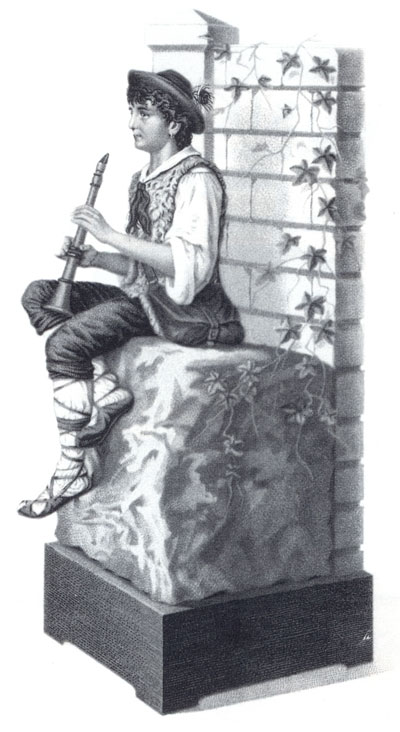
Flötenwerke and organ orchestrions were rarely produced in Leipzig. These instruments were based on mechanically or pneumatically operated organ pipes; perforated discs and paper rolls were used to store the musical information. Automated church organs were only manufactured by the POPPER Company.
Leipzig manufacturers of Flötenwerke and their product names with start of production:
| 1893 | Fabrik Leipziger Musikwerke vormals PAUL EHRLICH | Flötenwerk |
| 1895 | Fabrik Leipziger Musikwerke vormals PAUL EHRLICH | Savoyardenknabe, Bauernmusik-Automaten 61a,b |
| 1897 | Fabrik Leipziger Musikwerke vormals PAUL EHRLICH | Straßen-Drehorgel |
| 1898 | Fabrik Leipziger Musikwerke vormals PAUL EHRLICH | Orient |
| 1900 | Fabrik Leipziger Musikwerke vormals PAUL EHRLICH | Flötenbläser-Automat |
Leipzig manufacturers of organ orchestrions and their product names (when available) with start of production:
| 1895 | Hupfeld, Ludwig | Aeolion |
| 1895 | Fabrik Leipziger Musikwerke vormals PAUL EHRLICH | Bauernmusik-Automat 61c |
| 1899 | Zollinger | |
| 1901 | Apollo Musikwerke | |
| 1907 (ca.) | Hupfeld, Ludwig | Excelsior |
Leipzig manufacturers of automated church organs and their product names with start of production:
| 1910 | Popper | Eroica |